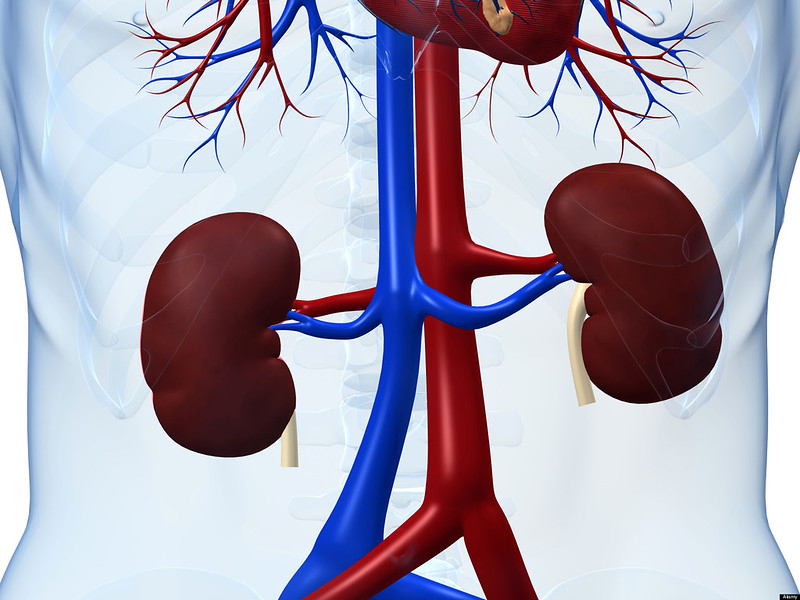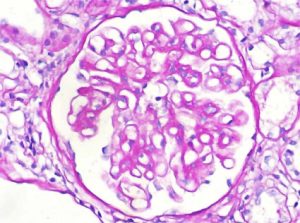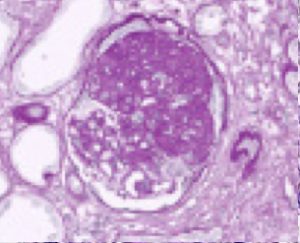Kidney Involvement
Vasculitis and the Kidneys
The kidney is a small bean-shaped organ located in the upper sides of the abdomen. People usually have 2 kidneys. They work to remove the body waste and extra water, and help keep the blood electrolytes (such as sodium and potassium) in balance. The kidneys also make hormones that help control your blood pressure and help produce red blood cells in the bone marrow.
Deep in each kidney, the working unit is called the nephron which is made of a small ball- shaped structure called a glomerulus and a long tube called a tubule to make the final urine. The kidneys have a lot of blood vessels inside the glomerulus and around each nephron.
Thus, kidneys are affected often by diseases in which there is inflammation of blood vessels, or vasculitis, especially in the following vasculitic diseases:
- Granulomatosis with polyangiitis (GPA)
- Microscopic polyangiitis (MPA)
- Eosinophilic granulomatosis with polyangiitis (EGPA)
- Polyarteritis nodosa (PAN)

Depending on the type of vasculitis and its severity, different changes can be seen in the kidney. Patients with GPA, MPA and EGPA can have variable degrees of inflammation and thickening of the walls of the blood vessels as well as inflammation in the tissue around the nephrons. There may be injury to the cells that make up the tubules of the nephrons, while the glomeruli can show inflammation with increased number of inflammatory and other cells. When vasculitis is more severe, the wall of the small blood vessels in the glomerulus may ruptured, leaking various cells. This will lead to the formation of a crescent which one can see under the microscope (Fig B). Usually, the more crescents seen on the biopsy, the more concern we have of that there is significant kidney injury. (Note: Patients with PAN do not have inflammation involving the nephrons, but rather have kidney problems related to vasculitis of medium-sized arteries which causes decreased blood flow to the entire kidney.)
If the inflammation and vasculitis has been going on for a long time, we start to see evidence of scarring (called fibrosis) inside the glomerulus and in the tissue around the nephrons (Fig C).
A: Normal glomerulus under light microscopy

B: inflamed glomerulus with a crescent

C: A glomerulus with scarring (fibrosis)

Kidney problems do not occur in everyone who has a diagnosis of vasculitis. However, kidney involvement is common, so your doctor will always perform studies to evaluate if your kidneys are involved or not. Some people whose kidneys are affected by vasculitis have symptoms. These can include elevated blood pressure, blood in the urine, decreased amount of urine and / or swelling in the body (especially face and lower legs). These can be visible signs of kidney disease and you need to tell your doctors quickly if you have these symptoms.
However, many patients have little or no symptoms. Therefore, your medical team will routinely screen for possible kidney disease by checking your blood pressure, doing tests on your urine (to check for blood, protein and/ or white blood cells) and evaluating kidney function by blood studies (checking levels of creatinine and protein).
When there are concerns about a kidney disease from vasculitis, your kidney doctor (nephrologist) will ask for kidney imaging (including kidney ultrasound and /or CT scan) and will usually recommend a kidney biopsy to better know the exact type of vasculitis and its severity. A kidney biopsy involves taking one or more tiny pieces of your kidney to look at under special microscopes. These microscopes make it possible to see the samples in greater detail. The biopsy is usually done through the skin, where a needle is placed through the skin that lies over the kidney and guided, with the help of ultrasound, to the right place in the kidney. This procedure is usually tolerated well, and your doctor will work with special doctors (such as anesthesia) to make sure there is minimal to no pain. The information learned from the kidney biopsy will help your doctors determine the best treatment options.
In severe cases (especially when the kidney biopsy shows many crescents and scarring), the patient may have significant swelling of legs or face, very high blood pressure (which sometimes may cause headache, nose bleeds or even seizures) and severe reduction in kidney function, requiring that the doctors start dialysis.
Dialysis is a procedure needed when kidney function is so low that the body waste and toxins build up in your bloodstream. Dialysis machines then will do the work of your kidneys, removing waste products and excess fluid from the blood until kidney function improves. In some cases, the kidney function will not return, and continued dialysis will be necessary. It these situations, the medical team works with the patient and family, striving to attain or to keep the vasculitis disease in remission so that the patient will become a candidate for a kidney transplant.
The best way to treat the kidney disease is to treat the vasculitis. This includes medicines, including glucocorticoids and other immunosuppressive medications to decrease inflammation and suppress the immune system. For some people, the development of kidney disease may result in changing these medicines to try to quiet the kidney inflammation as completely and quickly as possible. The goal is to give your kidneys and body the best chance to recover fully. Medications to control blood pressure are also commonly used in individuals with vasculitis.
It is important to talk to your medical team if you have concerns about your kidneys, such as seeing blood in your urine, tea or cola-colored urine, having body swelling or elevated blood pressure (hypertension). The earlier your kidney disease is found, the better it can be treated to prevent long term kidney damage.
It is also important to keep yourself well hydrated and to avoid medications that can cause kidney injury (such as large amounts of ibuprofen). Glucocorticoids are often used when doctors manage vasculitis. To decrease some of the potential side-effects of glucocorticoids, having a diet that is lower in sodium (to reduce risk of hypertension and/ or fluid retention) and high in calcium (to help with your bone health) can be helpful. Finally, if the kidney injury is severe and you are needing dialysis, your kidney doctors may limit your fluid intake.
Dialysis also may interrupt school attendance; however, your kidney doctor will try their best to limit these interruptions to a minimum and may also offer school tutoring during the dialysis sessions.
Contact your child’s kidney doctor or rheumatologist if you have any questions about kidney involvement in vasculitis.

